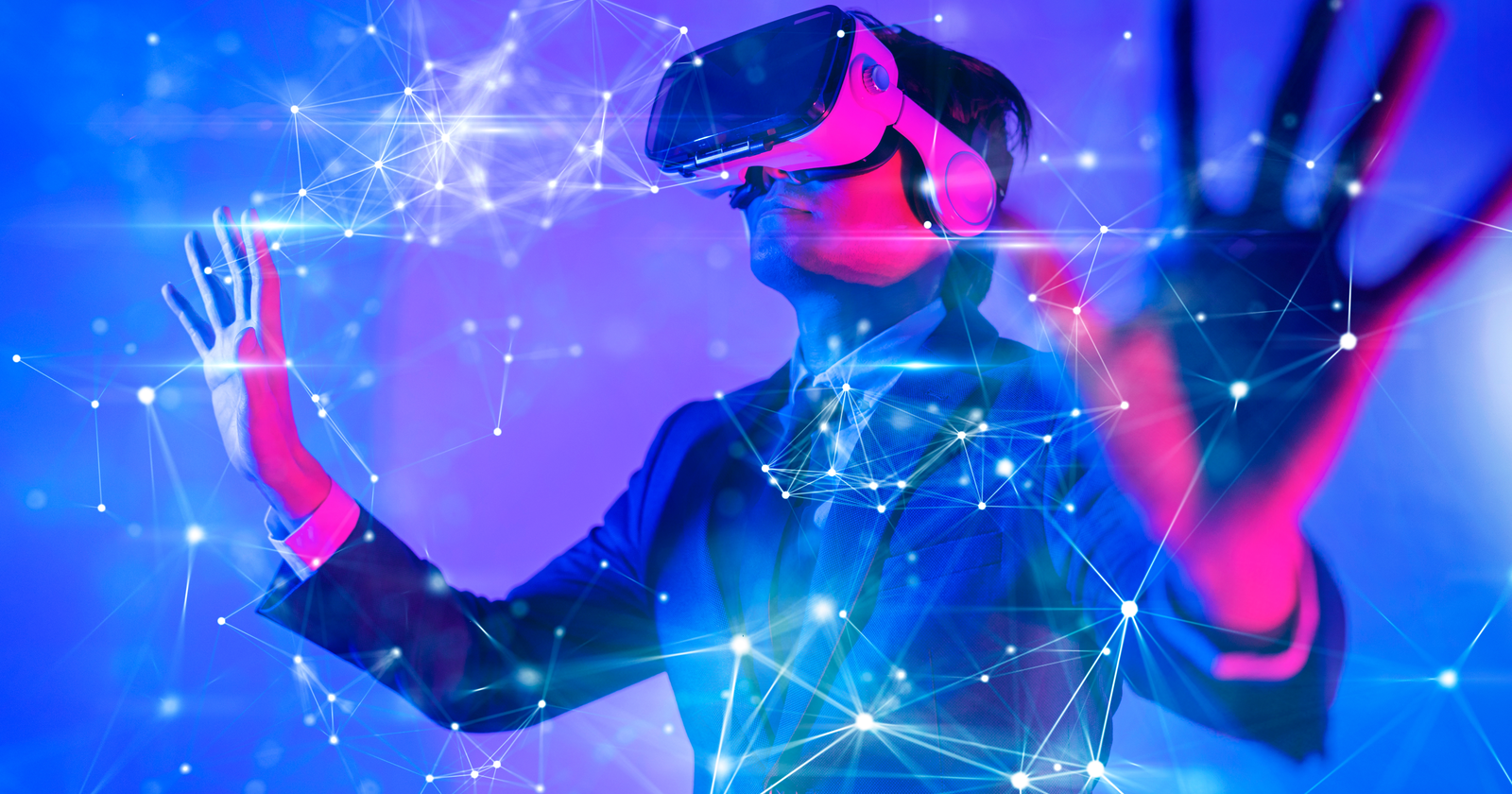Although the Metaverse’s infrastructure is still being set up, companies and brands are jumping on the opportunity to join this new world.
So if they are on board, how close are we to bringing the metaverse into full reality?
We’ve seen many changes in our society over the last few years, but nothing holds the potential for change quite like the Metaverse.
Last fall, when Mark Zuckerburg announced Facebook’s new parent company, “Meta,” the conversation of future societal implications of such an immersive social platform took the world by storm.
And for good reason.
Virtual reality, augmented reality, smart glasses, social media, and cryptocurrency have existed as separate yet related ideas until now.
The Metaverse combines these moving parts to create a powerful tool for businesses and marketers alike.
Zuckerburg announced Meta as a “social technology company” with a distinct focus on social responsibility that will change the way people work, socialize, and experience the world around them.
Normal physical boundaries do not limit this world, and therein lies its appeal for those looking for a more global reach.
But where did this concept come from, and where is it going?
Let’s find out.
Jump to:
- 1. The History Of The Metaverse
- 2. How Virtual Reality Got Its Start With Online Gaming
- 3. How Cryptocurrency Made The Metaverse Possible
- 4. How Major Brands Are Getting Involved
- 5. The Metaverse Is Closer Than Ever Before – In Fact, It’s Already Here
- 6. Is The Average Consumer Really Ready?
- 7. What To Expect From The Metaverse In 2022
The History Of The Metaverse
The term “metaverse” was first used by sci-fi writer Neal Stephenson to describe a 3D, virtual reality people could, in a sense, occupy. It was more theoretical than practical.
But in 2022, it’s coming to life. It is an immersive digital environment populated by virtual avatars representing actual people.
In the Metaverse, you can go about many of your everyday life’s day-to-day interactions and occurrences – in your avatar form.
This form can be a human, animal, or something more abstract with its customizable appearance.
You can then interact with other people’s avatars in this virtual world. In the Metaverse, you can buy and sell land, attend concerts and go to museums, build a house, and more.
In many ways, the Metaverse takes off where games like 2003’s Second Life began.
This creates a whole other level of interconnectivity and another dimension to our global economy.
How Virtual Reality Got Its Start With Online Gaming
The concept of virtual and augmented reality has been steadily leaked into mainstream culture over the last 20 years. The gaming industry was the first to really take advantage of it and integrate it into their platforms.
Games like Pokémon Go (2016) and Fortnite (2017) revolve around using these technologies to connect people through their apps.
Pokémon Go is one of the largest, most successful augmented reality games in the industry.
When its popularity exploded in 2016, it heralded a new era of AR’s integration into our everyday lives.
Fortnite, a virtual reality game using avatars to represent players, lets people fight against each other in real-time and attend events held in that particular metaverse.
These two highly popularized games helped introduce society to the concept of “extended reality” (XR).
Extended or mixed reality (XR) refers to all events that combine some element of what is real with what is virtual.
This includes augmented reality (AR) and virtual reality (VR) forms.
XR creates a more immersive experience for users and blurs the boundaries between reality and what is generated by technology.
This blend of realities creates infinite possibilities of integration for differing technologies to create a more holistic and immersive experience for users.
How Cryptocurrency Made The Metaverse Possible
Since the Metaverse is virtual, it is always active, self-sustaining, and creates incredible possibilities in business. And many of these possibilities hold a basis in cryptocurrency.
The advent of Bitcoin in 2009, alongside the general rising popularity of cryptocurrencies over the last decade, has ushered in a new era in which finance does not have to be physical.
With the recent surge of popularity in Ethereum and NFTs, cryptocurrencies are becoming a more legitimate form of financial exchange for the world at large – especially for investors and business leaders always looking to the horizon for new trends.
Conversations around these currencies will only become more and more mainstream in the coming years.
Virtual currency only complements this already virtual world and gives every person in the metaverse buying power. Businesses are noticing and following suit.
How Major Brands Are Getting Involved
Some of the businesses preparing for the Metaverse include major names such as Nike, Adidas, and Vans.
In October of 2021, Nike filed several trademark applications for their popular slogans and iconography (like “Just Do It” and the iconic checkmark), which will allow them to make and sell virtual goods.
This occurred in tandem with Mark Zuckerberg announcing Meta.
In December of last year, Nike announced their acquisition of virtual shoe company RTFKT studios, which will help them create shoes to sell in the Metaverse. This is incredible news for sneakerheads everywhere.
Adidas is making their foray into the Metaverse with collaborative NFT projects (which have since sold out), creating exclusive collectibles with other artists.
Their NFTs collectively sold for over $22 million. They’ve affirmed the NFT community by investing in NFTs as a company and have bought a large plot of land in the metaverse to host virtual parties and events.
They are one of the first corporations to not only release NFTs but to actually invest in the Metaverse ecosystem itself.
Vans is also getting involved.
The company has built an online skate park that’s already seen upwards of 48 million visitors.
This type of engagement is unparalleled. In-person events simply can’t hold the same capacity of people.
Customers can also shop in their virtual store to earn points and customize an avatar.
Brands aren’t just dipping their toes into the water – they’re diving in.
It’s time for others to follow suit.
The Metaverse Is Closer Than Ever Before – In Fact, It’s Already Here
The Metaverse’s infrastructure is still being set up, but companies and brands are jumping on the opportunity to be a part of this new world.
So if they are on board, how close are we to bringing the Metaverse into full reality?
What are the Metaverse’s potential effects on society as a whole, but specifically, the way we do business?
Mixed Reality And Virtual Conferences And Conventions
The pandemic catapulted society into a new era of digital innovation and created a significant need for advanced technologies that would allow us to continue our everyday business efforts from home.
Companies that depended on conferences and trade shows had to pivot, and fast.
The Metaverse offers significant opportunities for companies to meet through virtual reality, saving business and attendees money on travel, lodging, and other associated costs.
Employees and participants can put on VR glasses from the comfort of their homes and it’s as if they are there.
Bands and artists can host virtual concerts from anywhere in the world. The potential uses are nothing short of a revolution.
Targeting Millennials And Gen Z
Targeting millennials and Gen Z is of utmost importance to brands.
Digitally-native Gen Z has proven to be tricky to market to. They possess an intuitive understanding of technology unprecedented in previous generations.
They’re also more inundated than most other age groups.
According to some reports, Gen Z considers digital lives as important as physical ones. For some, there is little to no differentiation.
The virtual world and social media are not separate lives but further extensions of their more present, physical reality.
It also makes friendships around the globe more of a present reality and means exposure to brands they might not normally discover.
This boasts a two-fold impact on marketing and selling potential for brands – exposure is unlimited by physical constraints, and physical and digital goods become players of equal value.
Per Nike’s example, a virtual shoe is not of lessened value because it exists in the digital sphere – it holds the capability to compete (and won’t have to be cleaned with a toothbrush).
If a brand’s target audience is going digital, it’s no surprise that brands must pursue digital innovation to compete.
Now is the time for brands to see what possibilities the Metaverse can open up for them.
Early-stage adopters will only be rewarded in the long run.
A Deeper Level Of Customer Loyalty
The Metaverse doesn’t sleep. It exists in a 24/7 loop of information and interaction.
Marketers need to develop a real-time, boots-on-the-ground approach to customer loyalty to continue to succeed amidst such endless options for consumers.
Tapping into a deeper level of customer loyalty and relationship-driven marketing might sound like a no-brainer, but it’s a challenge for some.
The Metaverse is not as likely to replace your current marketing strategy as much as it will complement it.
Brands must stay true to who they are in a fully digital space. This I know from experience at AdRoll.
Our company’s platform deploys machine learning to help brands build loyalty in ecommerce.
In helping thousands of brands enhance customer loyalty, I can vouch that success in this arena does not come from technology alone, no matter how advanced – and the same principle applies in the Metaverse.
Once the Metaverse exists and functions in totality, winning over new customers will be more difficult than ever.
If your company has the bandwidth and resources, start focusing on creating an extremely loyal customer base that will follow you into the Metaverse as it grows and develops.
Is The Average Consumer Really Ready?
The Metaverse will push marketing and most of society deeper into digital innovation and immersion.
But are consumers ready? Early adopters might be excited to try, but what about those who are more reluctant?
It will simply take time for the technology to become more integrated with everyday life and society as a whole.
If you’re creating something that your target audience wants to be a part of, you’ll find success. Don’t join the Metaverse just to join it: Make sure you have something to offer.
Create a sense of community, and more reluctant participants will trust you enough to follow.
What To Expect From The Metaverse In 2022
In 2022, you can expect more hardware to come to everyday consumers. Apple has already invested in augmented reality, and their virtual reality headsets are coming later this year, with rumors of VR contact lenses circulating in recent weeks.
The creators of Pokémon Go are dabbling in augmented reality gear as well.
Brands like Burberry and Gucci already advertise and sell virtual goods using AR and VR. New hardware is set to release later this year.
Volumetric video is becoming more integrated into shopping experiences and some work-related events.
Buying virtual land in the Metaverse is on the rise, with some expecting to reap millions (if not billions) in revenue. To put it plainly, it isn’t just a trend – it’s here to stay.
Marketers should pay rapt attention to the evolution and progression of the Metaverse.
Those who are skeptical might miss out on a significant amount of digital innovation set to change the way society does business and functions as a whole.
More resources:
- Marketing in the Metaverse: The Future of Search & Social
- Marketing In The Metaverse [Podcast]
- Social Media Marketing: A Complete Strategy Guide
Featured Image: thinkhubstudio/Shutterstock




